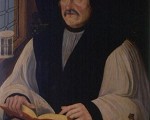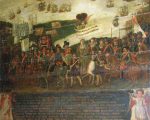
I hope you enjoyed the first part of our Spanish Armada quiz last week. Here’s the second part. Good luck!
[Read More...]
I hope you enjoyed the first part of our Spanish Armada quiz last week. Here’s the second part. Good luck!
[Read More...]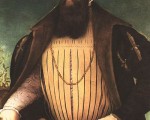
On this day in history, 6th August 1549, the Battle of Clyst Heath took place between the West Country rebels of the Prayer Book Rebellion and King Edward VI’s forces.
Upon hearing of the news of the massacre of around 900 rebels the previous day, two thousand rebels made their way to Clyst Heath where the Lords Russell and Grey were camped, and opened fire. The battle lasted all day, but the rebels were defeated in the end.
[Read More...]
In today’s Claire Chats video, Claire explains what she does on a daily basis and also asks for your help and feedback.
[Read More...]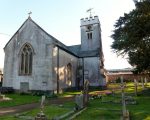
The Battle of Clyst St Mary, which was a battle fought during the Prayer Book Rebellion, took place on 5th August 1549 at the village of Clyst St Mary, 3 miles east of Exeter in Devon.
[Read More...]
Earlier in this series, I traced the journey of Jasper Tudor and his young nephew Henry’s escape from West Wales and their arrival in Brittany. The Tudors were welcomed to Vannes as guests of the powerful Duke Francis of Brittany before moving to the more remote Château de Suscinio for their own safety. The increased threat of abduction by York’s agents finally convinced Duke Francis to reduce the risk by moving them to separate locations inland.
Fourteen-year-old Henry was relocated to the Forteresse de Largoët, deep in the forest outside of the sleepy town of Elven. His custodian, Marshall of Brittany, Jean IV, Lord of Rieux and Rochefort, had two sons of a similar age to Henry, and it is thought they continued their education together. Henry was however prevented from communicating with his mother in England or his uncle Jasper Tudor, who now resided in a château elsewhere in Brittany.
[Read More...]
The Battle of Woodbury Common, part of the Prayer Book Rebellion, took place on 4th August 1549 on Woodbury Common, near the village of Woodbury in East Devon. The battle took place at 4am and happened when the rebels, who had been defending Clyst St Mary, marched to Woodbury Mill where Lord Russell and his troops had camped for the night. The rebels were defeated.
[Read More...]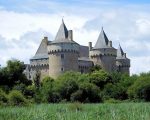
In the first two parts of this series, I followed Jasper Tudor and his fourteen-year-old nephew Henry’s escape from Tenby in Wales and their arrival in Brittany. The Tudors are recorded as spending a year in Vannes as guests of Duke Francis of Brittany but, in October 1472, the duke became concerned they might be abducted by York’s agents. They were moved to his remote ‘hunting lodge’ by the sea, south of Vannes, the Château de Suscinio.
The Tudors’ new home had been fortified in the fourteenth century by Breton knight Bertrand du Guesclin, nicknamed ‘The Eagle of Brittany’, a military commander during the Hundred Years’ War. As well as building the seigniorial residence block and a corner tower known as the Tour Neuve, the moat was deepened and a raising drawbridge added, together with casemates to house artillery. By the time the Tudors arrived, the original thirteenth century château resembled a castle of generous proportions.
[Read More...]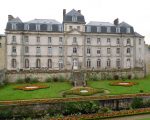
In the first part of this series, I followed Jasper Tudor and his young nephew Henry’s escape from Tenby in West Wales. There are tales of storms and of them being forced to shelter in the lee of the island of Jersey before they were able to make landfall at the Breton fishing port of Le Conquet in September 1471.
Jasper and Henry sought sanctuary from Duke Francis of Brittany and became his guests at the ducal palace, the Château de l’Hermine in Vannes. Duke Francis was a skilled politician, so would have appreciated the political value of the exiled Tudors to King Edward IV of England, as well as to his rival King Louis of France, to whom they were related through the Valois family of Jasper’s mother, Henry’s grandmother, Queen Catherine.
[Read More...]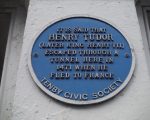
Henry Tudor’s return from exile to victory at Bosworth has to be one of the greatest moments in the history of the Tudor dynasty. So why is the Bosworth story so often told from the perspective of Richard III, with Henry depicted as lucky to have won?
I was born within sight of Pembroke Castle and have always been intrigued by the small room where the thirteen-year-old Lady Margaret Beaufort gave birth to the future king, Henry Tudor. I’ve also stood on the remote beach at Mill Bay near Milford Haven imagining how Henry would have felt as he approached with his uncle Jasper and his mercenary army.
All I knew about Jasper’s father, Henry’s grandfather, Owen Tudor, was that he’d been a Welsh servant who somehow married the young widow of King Henry V, Queen Catherine of Valois. Inspired to write a historical fiction trilogy about them, I wanted to research their stories in as much detail as possible and to sort out the many myths from the facts.
[Read More...]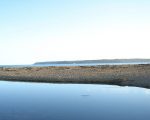
On 2nd August 1595, as part of the Anglo-Spanish War of 1585-1604, four galleys containing somewhere between 200 and 400 Spanish soldiers landed at Mount’s Bay on the coast of western Cornwall. The fleet was commanded by Captain Carlos de Amésquita and it had left Port Louis, Brittany, France, on 26th July to raid the south-west of England.
[Read More...]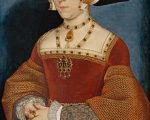
We can learn a lot about history from the way people were buried. Lauren Browne examines the representation of queenship in funeral and burial traditions in this brand new exclusive Tudor Society expert talk.
[Read More...]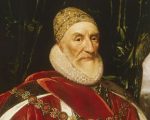
By the first week of August 1588, the battered, defeated and demoralised Spanish Armada had started the first part of its long journey back home to Spain.
The Battle of Gravelines had seen England victorious, and between that and the awful weather Spain had lost five of its main ships and had suffered major damage to many others. Ammunition was pretty much non-existent and food rations were low. All the Spanish commander, the Duke of Medina Sidonia, could do was to try and salvage what was left of his fleet and men and get them home to safety. The English fleet, led by Lord Howard, pursued the Spanish ships as far north as the mouth of the Tyne but gave up on the 2nd August and turned back, dropping anchor at ports such as Harwich and Margate.
[Read More...]